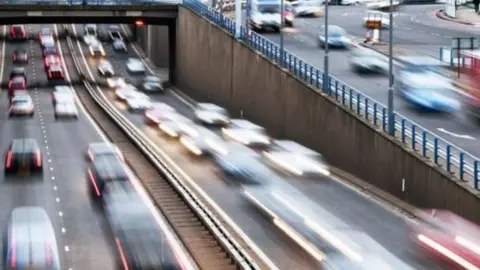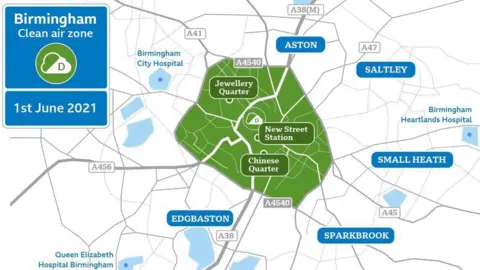Clean Air Zone: Birmingham reports drop in emissions
 Getty Images
Getty ImagesThe air quality in Birmingham city centre has improved since the introduction of the Clean Air Zone last year, the council has said.
Nitrogen dioxide levels dropped by 13% in the first six months of the scheme.
The number of polluting vehicles now travelling into the city centre has also halved to 9.2%.
The local authority is now offering grants to small businesses to encourage them to upgrade their vehicles.
"I am pleased to say we have made good progress towards our goal of improving air quality in the city centre but we cannot rest on our laurels", Liz Clements, cabinet member for transport, said.
The Clean Air Zone was first introduced on 1 June last year and saw drivers of a vehicle not meeting emission standards being charged a daily fee of £8 for cars, vans and taxis, or £50 for HGVs and coaches.
All roads inside the A4540 Middleway ring road fall into the zone, but the circular route itself is not included.

West Midlands based companies who use LGVs in their fleet can now apply for grants of up to £4,000 per vehicle to help fund upgraded or replacement vehicles.

What does the data show?
Dr Stephen Worrall a lecturer in chemistry at Aston University said the figures were encouraging, but a full-year cycle of data was required.
"It's really positive news," he said.
"We knew vehicle numbers in the city centre were looking positive anyway, but in the most polluting category they're dropping really steadily - it's the proportion that we needed, evidence on nitrous dioxide levels, so that's really good information from the council."
He said the pandemic may also have had an effect on the number of cars on the road.
However, he said it was also possible residents in the city were changing their behaviours to deal with the Clean Air Zone.
Dr Worrall added there was also a "seasonal" element.
"In winter, cars are used more than public transport, so we need a full year of data, but it sounds positive," he said.
"The crucial bit is the drop in nitrous dioxide - and to see that it's working and not just costing people money for no reason."

The council has also increased the Ultra Low Emission Vehicle (ULEV) grant available to Birmingham-licensed Private Hire and Hackney carriage drivers.
Both groups can now apply for a grant of up to £10,000 to cover the operating expenses associated with running a ULEV.

Follow BBC West Midlands on Facebook, Twitter and Instagram. Send your story ideas to: [email protected]
